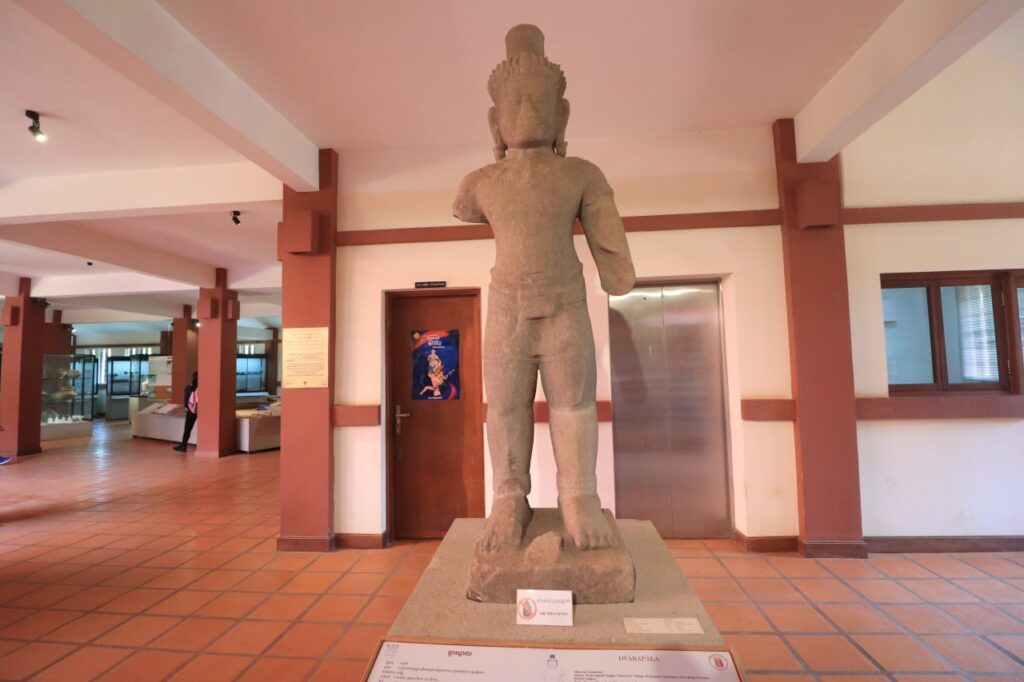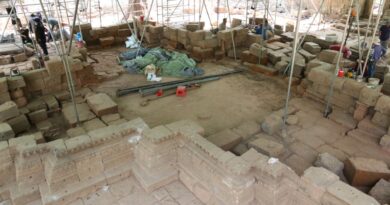បដិមាទ្វារបាល ដែលកសាងឡើងពីថ្មភក់ដ៏ធំ កម្ពស់១,៨២ម៉ែត្រ ទទឹង០,៧៨ម៉ែត្រ និងកម្រាស់០,៥ម៉ែត្រ រចនាប័ទ្មបាយ័ន ចំនួន១ ត្រូវបានជួសជុលឱ្យល្អប្រសើរឡើងវិញ និងបានដាក់តាំងបង្ហាញនៅក្នុងសារមន្ទីរព្រះនរោត្តមសីហនុ-អង្គរ បន្ទាប់ពីកំណាយរកឃើញបដិមារូបទ្វារបាលនេះ បានកប់ក្រោមដីនៅបរិវេណប្រាសាទទន្លេស្ងួត ដែលមានសភាពខូចខាតជាច្រើនកន្លែង។
ប្រធានក្រុមការងាររៀបចំពិព័រណ៍ និងជាមគ្គទេសក៍នៅសារមន្ទីរព្រះនរោត្តមសីហនុ-អង្គរ លោក គុន ផល្លី ឱ្យដឹងថា បដិមាទ្វារបាលដ៏ធំមួយនេះ បាក់បែកជា៦បំណែកផ្សេងៗគ្នា ដូចជាព្រះកេស ដងខ្លួន ដៃ-ជើង និងក្រវិល។ រីឯផ្ទៃមុខក៏បានសឹករិករិលស្ទើរតែបាត់បង់ទម្រង់បបូរមាត់ ច្រមុះ និងភ្នែកផង។ ក្រោយពីក្រុមកាងារបានសិក្សាអំពីប្រវត្តិបដិមា ក្បាច់លម្អ និងទំហំខូចខាតទាំងផ្ទៃខាងក្នុង និងផ្ទៃខាងក្រៅ ដោយប្រើបច្ចេកទេសជួសជុលទៅតាមដំណាក់កាលនីមួយៗ ហើយបានតភ្ចាប់តាមទម្រង់ដើមវិញ។ បន្ថែមលើនេះ ដើម្បីតម្កល់បដិមាទ្វារបាលឱ្យមានលំនឹងនិងមានសុវត្ថិភាព ក្រុមការងារ ក៏បានធ្វើជើងទម្រថ្មីពីថ្មភក់ព្រមទាំងរៀបចំផ្ទាំងព័ត៌មានអំពីប្រវត្តិបដិមា ដាក់តាំងបង្ហាញនៅក្នុងសារមន្ទីរព្រះនរោត្តមសីហនុ-អង្គរ ដើម្បីឱ្យភ្ញៀវដែលចូលមកទស្សនា បានសិក្សានិងស្វែងយល់ពីការវិវត្តនៃប្រវត្តិសិល្បៈខ្មែរ។
បដិមាទ្វារបាលដ៏ធំមួយនេះ ត្រូវបានគេប្រទះឃើញនៅពេលធ្វើកំណាយស្រាវជ្រាវកាលពីឆ្នាំ២០១៧ នៅភាគខាងជើងនៃអតីតក្រុងអង្គរធំ ត្រង់ប្រាសាទទន្លេស្ងួត ដែលជាមន្ទីរពេទ្យបុរាណនៅសម័យអង្គរ ដែលទីតាំងបច្ចុប្បន្នស្ថិតនៅភូមិនគរក្រៅ សង្កាត់គោកចក ក្រុងសៀមរាប។ ក្រុមអ្នកស្រាវជ្រាវបានសន្និដ្ឋានថាបដិមាទ្វាបាលនេះ អាចត្រូវបានកសាងឡើងនៅចុងសតវត្សរ៍ទី១២និងដើមសតវត្សរ៍ទី១៣ នៃគ្រីស្ដសករាជ។
លោក គុន ផល្លី បានពន្យល់ថា បដិមាទ្វារបាលក្នុងសិល្បៈខ្មែរដំបូងៗត្រូវបានគេប្រទះឃើញនៅតាមជញ្ជាំងប្រាសាទឥដ្ឋ របស់ក្រុមប្រាសាទសំបូរព្រៃគុកនៅអំឡុងសតវត្សរ៍ទី៧-៨នៃគ្រីស្ដសករាជ។ ក្រោយមកបដិមាទ្វារបាលត្រូវបាននិយមកាន់តែច្រើនឡើងនិងវិវត្តទៅជាបដិមាទ្វារបាលទោល ក្នុងរចនាប័ទ្មប្រែរូបអំឡុងសតវត្សរ៍ទី១០នៃគ្រីស្ដសករាជ និងបន្តដល់រាជព្រះបាទជ័យវរ័្ននទី៧ ឆ្នាំ១១៨១ ដល់ឆ្នាំ១២២០នៃគ្រីស្តសករាជ។ ជាទូទៅបដិមាទ្វារបាលទោលនៅក្នុងរាជព្រះបាទជ័យវរ្ន័នទី៧ មានមាឌធំ កម្ពស់ខ្ពស់ នៅលើដងខ្លួនមានលម្អទៅដោយគ្រឿងអលង្ការ ដូចជា មកុដ ក្រវិល សុរងក កងដៃ កងជើង។ នៅក្នុងដៃទ្វារបាលជាទេវៈមានកាន់កេតនភណ្ឌជាដំបងត្រីសូល៍។ ចំពោះទ្វារបាលនេះក៏មានជាអសុរដែរ។ រីឯទ្វារបាលជាអសុរវិញ គឺមានកាន់ដំបងទ្រវែងជាដើម៕
អត្ថបទ: យី សុថា
រូបភាព: ហ៊ុ រិទ្ធី និង គុន ផល្លី
A sandstone door guardian statue, 1.82 meters high, 0.78 meters wide, and 0.5 meters thick, has been repaired and displayed in the Preah Norodom Sihanouk-Angkor Museum.
The head of the exhibition team and the guide at the Preah Norodom Sihanouk-Angkor Museum, Mr. Kun Phally, said that the door guardian statue was broken into six different pieces, such as the head, body, arms, legs, and earrings. The face was also eroded, almost losing the shape of the lips, nose, and eyes. After the team studied the history of the statue, the decoration, and the size of the damage, both inside and outside, the experts used the repair technique according to each stage and reconnected to the original form. In addition, to keep the door guardian statue stable and secure, the team also made a new sandstone pedestal and prepared a poster about the history of the statue on display in the Preah Norodom Sihanouk-Angkor Museum for visitors to study and understand the evolution of Khmer art history.
This huge door guardian statue was found during excavations in 2017 at the Tonle Snguot temple, an ancient Angkorian hospital in the north of the former city of Angkor Thom, now located in Nokor Krao village. Kork Chak, Siem Reap city. Researchers have speculated that the statue may have been built in the late 12th and early 13th centuries AD.
Kun Phally explained that the first door guardian statue of Khmer art was found on the brick walls of the Sambor Prei Kuk group of temples during the 7th-8th centuries AD. Later, the door guardian statue became more popular and evolved into a single door in the Pre-Rup style during the 10th century AD and continued to King Jayavarman VII from 1181 to 1220 AD. In general, the single-door guardian statue in the reign of King Jayavarman VII was big and tall on the body, adorned with ornaments such as crowns, earrings, necklaces, bracelets, and ankles. In the hand of the door guardian statue holding a trident but this guardian statue holding a long stick.
Article: Yi Sotha
Photos: Hum Rithy and Kun Phally





